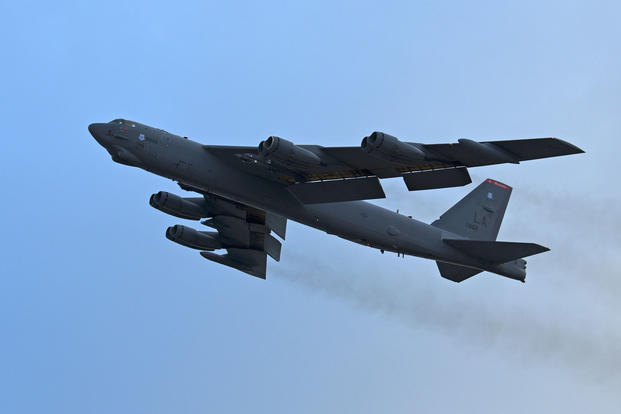U.S. Air Force officials are looking to upgrade the B-52 Stratofortress' bomb load at a time when the service, and the Defense Department as a whole, is preparing for near-peer rivals.
The service last month posted a request for information survey to identify potential contractors that could offer insights on how to best integrate newer and much heavier bombs under the aircraft's wings.
Given that the aircraft is expected to fly for another 30 years, the potential upgrade -- part of the Heavy Weapon Release Pylon Program -- speaks to the Air Force's initiative to stay ahead of emerging threats, particularly aggressors in the Pacific, according to a service official.
"This is not a requirement that came out of nowhere," the service official told Military.com on background Monday. "There are compelling reasons for why we have to go down that road."
Related content:
- Air Force to Create Global Space Training amid Russia, China Threats
- Without New Nuclear Weapon, B-52 Bomber Mission Ends, General Warns
- B-1 Crews Prep for Anti-Surface Warfare in Latest LRASM Tests
While specific munitions haven't been advertised, the goal is to quadruple the bomb size. Officials want pylons "capable of carrying multiple weapons in the 5,000-lb to 20,000-pound weight class," according to the RFI. The current common pylon maximum is for 5,000-pound munitions.
The external pylon "was designed in 1959 and has been in service since the 1960s. When it was introduced, there wasn't a requirement nor did anyone foresee a need to carry weapons heavier than 5000 lbs," the RFI states.
Now that's changed, the official said.
"High-end competitors are driving these choices," the service official said, referencing the Defense Department's latest National Defense Strategy.
According to the 2018 NDS, "China is a strategic competitor using predatory economics to intimidate its neighbors while militarizing features in the South China Sea.
"It is increasingly clear that China and Russia want to shape a world consistent with their authoritarian model -- gaining veto authority over other nations' economic, diplomatic and security decisions," the NDS says.
Air Force Secretary Heather Wilson has on multiple occasions referenced China's quick pace in technological development, which is driving the service to react. There has been explicit recognition "of the re-emergence of great power competition," she has said.
"[China] is modernizing very quickly. They're modernizing their air defenses, but also their air-to-air capability is really modernizing across the board. It is the pacing threat for the U.S. Air Force because of the pace of their modernization," she told reporters at the Pentagon in February.
The official also pointed to the bomber road map, which enhances the B-52 aircraft as a whole.
The service debuted the new "Bomber Vector" strategy alongside its fiscal 2019 budget rollout, which aims to allocate more resources for the nuclear-capable BUFF, or "Big Ugly Fat Fellow."
The Air Force is pushing for a major engine overhaul for the bomber as it intends to keep the long-range B-52 flying into the 2050s.
The B-52 is no stranger to the Pacific. In January, the B-52 swapped back in for the B-1B Lancer at Andersen Air Force Base, Guam.
The move marked a significant shift to bring back the B-52H, which previously filled the continuous bomber presence mission from 2006 to 2016 before the B-1 briefly took over.
Bringing the B-52 back meant putting a nuclear-capable bomber in theater at a time when relations between the U.S. and North Korea were largely unpredictable, and as China continued to flex its muscles in the South China Sea.
The B-52 in recent weeks has made appearances near the South China Sea as tensions over the man-made territory remain high.
Last month, Defense Secretary Jim Mattis said there could be repercussions for China if it doesn't curtail its expansion and aggressive behavior in the region.
"It was time to say there's a consequence to this," Mattis said at the 2018 Shangri-La Dialogue on June 2.
Weeks earlier, the Defense Department disinvited China from the Rim of the Pacific Exercise, known as RIMPAC, the world's largest international maritime warfare exercise.
"Nothing wrong with competition, nothing wrong with having strong positions, but when it comes down to introducing what they have done in the South China Sea, there are consequences," Mattis said.
As for the B-52 bomb pylon upgrade, the program is in the early stages.
The RFI "is only for market research of possible contractor sources," said Stephen Palmer, a contracting officer with Air Force Life Cycle Management Center who specializes in the B-1 Lancer and B-52 programs at Tinker Air Force Base, Oklahoma.
"[We] are not asking for any contractor to provide a proposal at this time," he said in an email.
-- Oriana Pawlyk can be reached at oriana.pawlyk@military.com. Follow her on Twitter at @Oriana0214.









